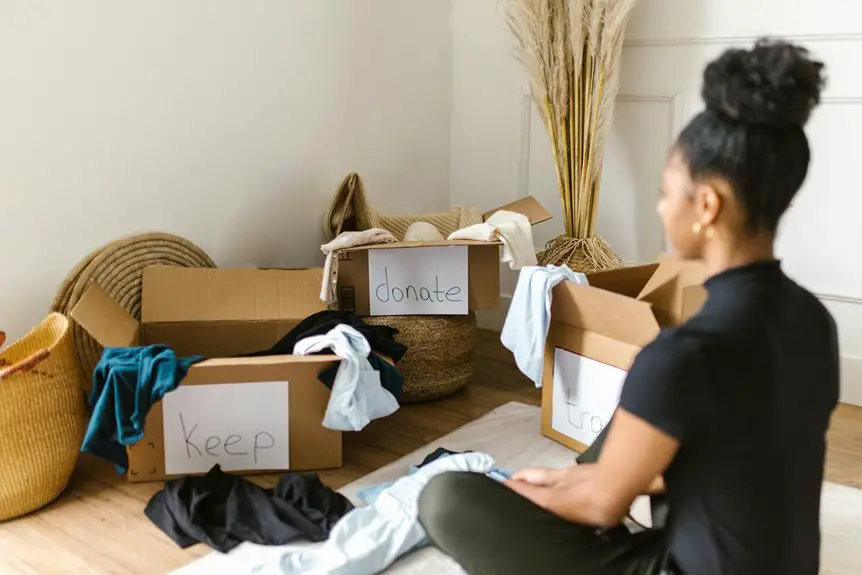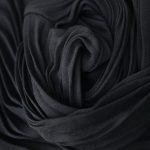To keep your velvet looking plush, first identify its type—cotton, silk, or synthetic—as each needs different care. Gently brush or steam regularly to remove dust and lift the pile, avoiding direct sunlight to prevent fading. For stains, blot water-based spills and treat oil stains with baking soda. Use mild detergents for spot cleaning, and always test on a hidden area. Proper storage also protects velvet’s texture and shape. Learn more tricks to maintain your velvet’s luxurious feel and appearance.
Table of Contents
Key Takeaways
- Gently brush velvet regularly with a soft-bristled brush or lint roller to remove dust and maintain texture.
- Blot stains immediately; use baking soda for oil stains and rubbing alcohol for ink, avoiding soaking the fabric.
- Clean velvet with mild detergent diluted in lukewarm water, testing solutions on hidden areas before spot cleaning.
- Use a handheld steamer to lift the pile and remove wrinkles without oversaturating the fabric.
- Store velvet in cool, dry places away from sunlight, using padded hangers or laying flat to prevent damage.
Understanding Different Types of Velvet Fabric
Although velvet may look similar across various pieces, understanding the different types of velvet fabric is essential before you clean it.
Knowing the various velvet types is key to proper cleaning and maintaining fabric quality.
You’ll find that velvet varies based on its weave, fiber content, and texture. For example, cotton velvet is durable but can shrink if washed improperly, while silk velvet is delicate and requires gentle handling.
Synthetic velvets, like polyester, are often more stain-resistant and easier to clean. You should also know the difference between crushed velvet, which has a textured, shiny surface, and velour, which has a plush, even pile.
Identifying your velvet type helps you choose the right cleaning method, preventing damage like matting or color loss. Always check the care label to understand your fabric’s specific needs before proceeding.
Daily Maintenance Tips for Velvet
Regularly caring for your velvet fabric can keep it looking fresh and luxurious for years.
Start by gently brushing your velvet with a soft-bristled brush or a lint roller to remove dust and debris. Avoid pressing too hard to maintain the fabric’s pile.
Rotate cushions or pillows regularly to guarantee even wear and prevent flattening in specific areas.
Keep velvet away from direct sunlight, which can cause fading.
Use a handheld steamer to lift the pile and remove wrinkles, but don’t over-saturate the fabric.
If your velvet gets damp, blot it immediately with a clean, dry cloth.
How to Remove Common Stains From Velvet
When you spill something on velvet, acting quickly can prevent permanent damage. First, gently blot—never rub—the stain with a clean, dry cloth to absorb excess liquid. Next, identify the stain type to choose the right approach.
| Stain Type | Removal Tip |
|---|---|
| Water-based | Blot with a damp cloth, air dry |
| Oil-based | Sprinkle baking soda, then brush |
| Ink | Dab with rubbing alcohol carefully |
For water-based stains, avoid soaking velvet; for oil-based, baking soda lifts the grease before brushing it off. Ink requires delicate dabbing with rubbing alcohol on a cotton swab—test first on a hidden spot. Always handle velvet with care to maintain its texture and appearance.
Safe Cleaning Solutions and Tools for Velvet
Because velvet is delicate, you’ll want to choose cleaning solutions and tools that protect its soft texture while effectively lifting dirt and stains.
Start with a mild detergent mixed with lukewarm water; avoid harsh chemicals or bleach that can damage the fabric. Spot test any solution on an inconspicuous area first.
Begin with a mild detergent and lukewarm water, avoiding harsh chemicals; always spot test first on a hidden area.
Use a soft-bristled brush or a microfiber cloth to gently clean the surface—never scrub aggressively, which can crush the pile. A handheld steamer can refresh velvet and remove wrinkles without soaking it.
Avoid soaking velvet; excess moisture can cause water stains or shrinkage. For dry cleaning, always check the care label and consider professional services for valuable or heavily soiled velvet items.
With the right supplies, you’ll keep your velvet looking plush and vibrant.
Step-by-Step Guide to Deep Cleaning Velvet
Although deep cleaning velvet requires extra care, you can restore its luxurious look by following a few precise steps.
First, vacuum the fabric gently using a soft brush attachment to remove surface dust and dirt.
Next, spot clean stains with a mild detergent mixed with water, dabbing carefully with a clean cloth—never rub.
Finally, allow the velvet to air dry completely while avoiding direct sunlight or heat sources.
To visualize the process, imagine:
- Running a soft brush lightly over the velvet’s rich texture
- Gently blotting a stain with a dampened white cloth
- Watching the fabric dry naturally, regaining its plush feel
Professional Cleaning vs. DIY Methods
Deciding whether to hire professionals or tackle velvet cleaning yourself depends on your comfort level and the fabric’s condition.
If your velvet item is heavily stained or antique, professional cleaning is safer—they have specialized equipment and expertise to avoid damage.
On the other hand, if you notice minor stains or routine dirt, DIY methods can be effective and cost-efficient. Just make sure you use the right cleaning products and follow proper techniques to preserve the fabric’s texture and color.
Remember, DIY cleaning carries risks if you’re unsure, potentially causing irreversible harm.
Ultimately, weigh the fabric’s value and your confidence in cleaning before deciding. When in doubt, opting for professional help can save you time and protect your velvet investment.
Storage and Long-Term Care for Velvet Items
After cleaning your velvet items, proper storage and long-term care play a big role in keeping them looking their best.
Proper storage and care are essential to maintain the beauty and texture of your velvet items.
You want to prevent crushing the pile and avoid exposure to moisture or direct sunlight, which can damage the fabric. Always store velvet in a cool, dry place, and use breathable garment bags to protect your pieces without trapping humidity.
When hanging velvet garments, choose padded hangers to maintain their shape and prevent creases.
Here are key tips for velvet storage and care:
- Lay velvet items flat when possible to avoid pressure marks
- Keep velvet away from sharp objects that could snag the fabric
- Brush velvet gently with a soft clothes brush to maintain its plush texture
Following these simple steps will help preserve your velvet’s rich look and feel.
Frequently Asked Questions
Can Velvet Fabric Cause Allergies or Skin Irritation?
Oh, velvet causing allergies? You’d think it’s a cozy hug, but yes, it can irritate sensitive skin or trap allergens. If you’re prone, you’ll want to keep it clean and maybe test before cuddling up.
How Does Humidity Affect the Texture of Velvet?
Humidity makes velvet fibers absorb moisture, causing the texture to feel heavier and less plush. You’ll notice the fabric may become limp or develop slight wrinkles, so controlling humidity helps keep velvet soft and smooth.
Are There Eco-Friendly Cleaning Products Suitable for Velvet?
You might think eco-friendly cleaners are too harsh for velvet, but they’re actually gentle and effective. Look for plant-based, non-toxic products specifically labeled safe for delicate fabrics to keep your velvet fresh without harming the environment.
Can Velvet Fabric Be Recycled or Repurposed?
You can recycle or repurpose velvet fabric by turning it into cushions, bags, or patchwork projects. Since it’s delicate, make sure to clean it gently first, and consider donating leftover pieces to craft enthusiasts.
What Is the History and Origin of Velvet Fabric?
You know what they say, “Old is gold.” Velvet originated in ancient India, spreading to Europe by the Middle Ages. You’ll find its luxurious texture symbolized wealth and nobility throughout history, enchanting cultures worldwide.






